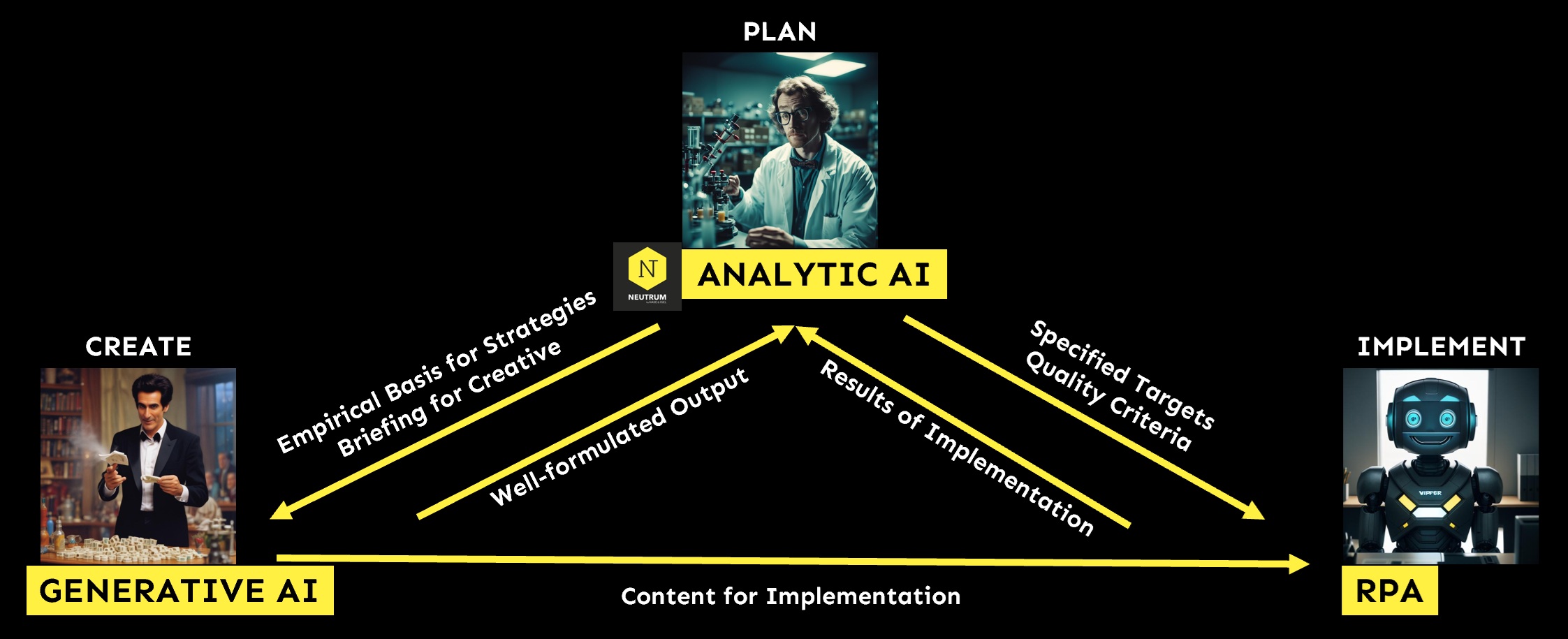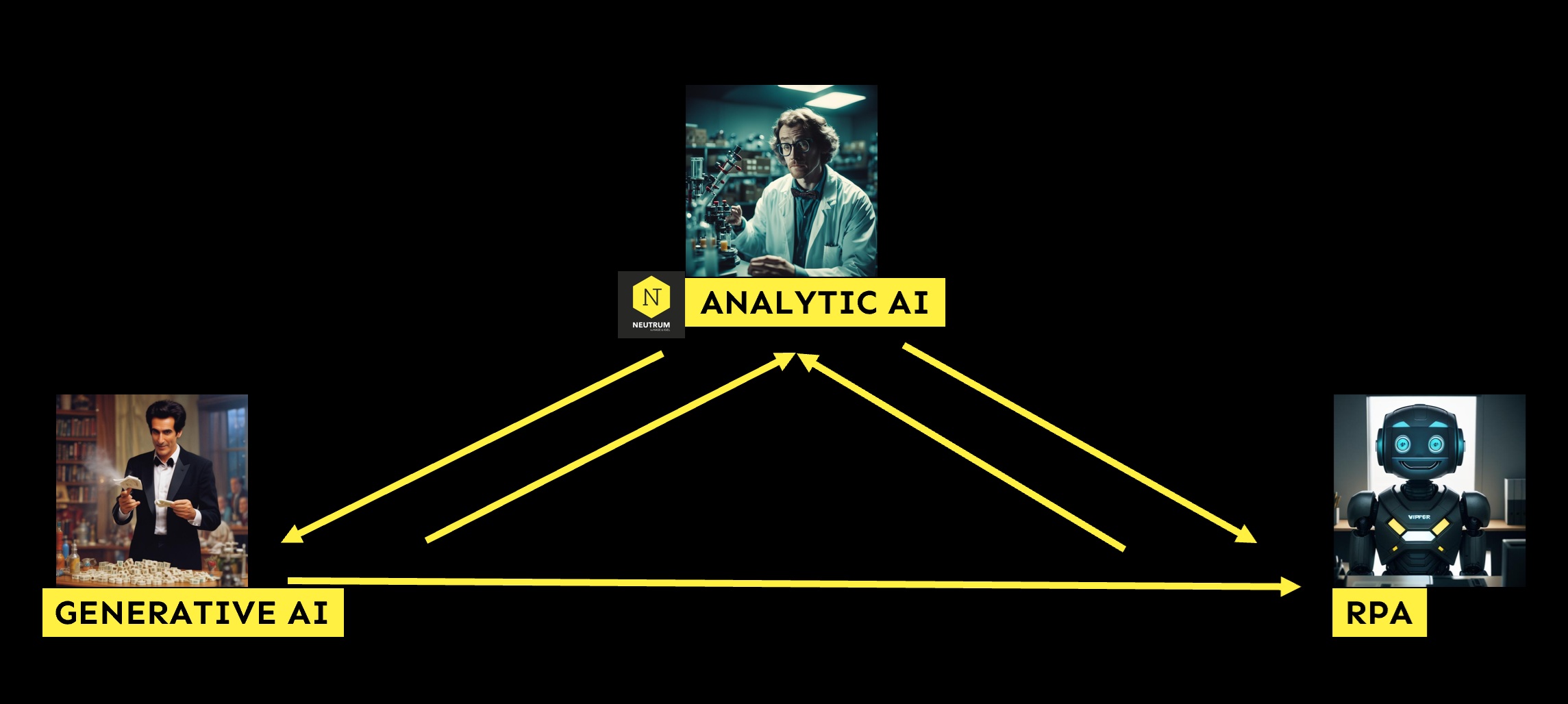Will I use AI in my business? That is not a matter of if, but when. Let’s say I have identified the application domain where I want to deploy Artificial Intelligence. What kind of AI will I use? Businesses and organizations will want to combine different types of AI technologies. By the same token, you would not want to be without an electric drill in your toolbox any more than you would a hammer or a screwdriver.
Our domain of expertise is Analytical AI. Our AI solution is reliable and fully explainable. AI is becoming ever more important for companies in the context of the now enacted EU AI Act. To avoid being trapped in tunnel vision, we have developed a model of how Analytical AI, Generative AI and Robotic Process Automation can work together optimally. Together with our customers, we are already implementing AI. Let us take a look at what an integrated “AI operating system” looks like. We’ll use the example of marketing and sales:
The golden triangle of AI - intelligent automation in all the right places
We use various tools in our home renovation projects. We drill holes in the wall with a drill. We hammer the nails. And we drive in the screws with a screwdriver. By the same token, we deploy different kinds of AI for various business applications. The key factor here is which tool and in which order.
- Analytic AI is involved right from the start - as an input provider: it analyzes the data in a reliable manner. It identifies key success drivers and market opportunities at a high degree of granularity—by customer, product, channel, advertising media or location. We use it all to come up with the right specifications, strategies and plans.
- Generative AI creates convincing text and image content for personalized advertising, dynamic websites or intelligent chatbots for the different product trends, success drivers and target groups.
- Robotic Process Automation (RPA) uses the criteria and recommendations of analytical AI and the content of Generative AI to automate processes. Examples include advertising targeting and placement and content planning.
The end results are continuously reviewed by Analytic AI in order to optimize recommendations and measurements. This all creates a control loop with which the AI system achieves ever better results and quickly adapts to new environmental conditions, e.g. changed market demand, competition, advertising and sales channels.
The following diagram illustrates this interaction:

Want to go deeper? Nice - then let's go into detail!
The Combined Power of Analytical and Generative AI
In the AI ecosystem, analytical AI serves as a kind of navigation system that shows us the way to a promising marketing and sales strategy. The basis for this is external data (3rd party) on demand, competition and the environment, together with your company's own data (1st & 2nd party).
The task of Analytic AI is to tame the data collected in the wild, for instance online consumer behavior or statements and the multifarious data silos and systems in the through integration and structuring, to recognize the correlations and success levers and to make reliable forecasts for various scenarios on this basis. All of this is done thousands of times faster than a human and without careless errors, so that the world now turns much faster and more efficiently for you in everything that has to do with data collection and analysis.
Generative AI has been thus far prone to hallucinations. Gen AI behaves as a black box—and cannot disclose on the basis of which data it comes to a conclusion. However, Analytical AI can be made completely explainable, transparent and comprehensible. Statements are substantiated and sources are disclosed. Analytic AI is less susceptible to clichés and distortions, because it is trained to see the world as objectively as possible - instead of being as entertaining as possible.
Analytic AI can be combined with Generative AI to create new forms of advertising and media. It can provide reliable insights into which products and topics in which channels and formats and in which formatting (from keywords to arguments to aesthetics) are most likely to reach your advertising targets. With the result obtained from Analytic AI, you can instruct (or prompt) Generative AI more precisely so that results are more to the point. From that point on, Generative AI can usefully automate the production of content, landing pages, chatbots and apps, thus rapidly reducing the cost of creation.
Analytic AI and RPA: Segmentation, targeting and media strategy can also be automated
Analytic AI can also serve as the basis for segmentation targeting and media strategyAnalytic AI algorithms verifiably show which segments there are among the target groups, what is important to them and which products have the best chance in which segment, market area and channel. Once we have transparently identified the attractive products and segments, it is important to address them as precisely as possible. This takes us into the area of targeting and data-driven media planning. We can thus decide on which channel with which advertising medium to address.
The combination of Big Data and Analytic AI makes the effect of advertising clearly measurable You can see for instance how many store visits, applications or positive mentions you have received from a radio spot compared to what you would have received without a particular advertising. You can thus measure how effective a medium has been. The old content marketing question of the best time to go out with a certain topic per channel (e.g. on TikTok) can be thus answered clearly. Analytic AI can automate your media mix modeling. It can also provide you directly with a ready-made media strategy including the exact schedule.
For example, you can see how many more shop visits, applications or positive mentions you have received from a radio advert than you would have received anyway... and what is really a reliable effect of this medium. The old content marketing question of the best time to go out with a certain topic per channel (e.g. on TikTok) can also be answered clearly. Analytical AI can therefore not only automate your media mix modelling - it can also provide you with a ready-made media strategy, including a precise schedule.
Robotic Process Automation (RPA) can then take over your process to accelerate it and make it more efficient. It uses Analytica AI to automatically book advertising spaces based on their availability at the best prices (depending on the bidding of competitors). It combines advertising media created with Generative AI in a meaningful way. It plays them out and places personalized content in dynamic websites or in emails. RPA works in tandem with Analytic AI to ensure that your emails and posts are sent at the right time (Send-Time Optimization, Fatigue Analysis), in the right context, thus increasing the conversion rates and detecting issues early on, to reduce potential customer churn, suggesting countermeasures to retain the existing customers.



